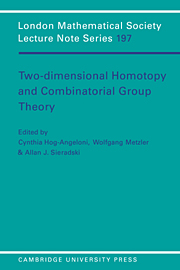Book contents
- Frontmatter
- Contents
- Editors' Preface
- Addresses of Authors
- I Geometric Aspects of Two-Dimensional Complexes
- II Algebraic Topology for Two Dimensional Complexes
- III Homotopy and Homology Classification of 2-Complexes
- IV Crossed Modules and Π2 Homotopy Modules
- V Calculating Generators of Π2
- VI Applications of Diagrams to Decision Problems
- VII Fox Ideals, N-Torsion and Applications to Groups and 3-Manifolds
- VIII (Singular) 3-Manifolds
- IX Cancellation Results for 2-Complexes and 4-Manifolds and Some Applications
- X J. H. C. Whitehead's Asphericity Question
- XI Zeeman's Collapsing Conjecture
- XII The Andrews-Curtis Conjecture and its Generalizations
- Bibliography
- Index
III - Homotopy and Homology Classification of 2-Complexes
Published online by Cambridge University Press: 20 January 2010
- Frontmatter
- Contents
- Editors' Preface
- Addresses of Authors
- I Geometric Aspects of Two-Dimensional Complexes
- II Algebraic Topology for Two Dimensional Complexes
- III Homotopy and Homology Classification of 2-Complexes
- IV Crossed Modules and Π2 Homotopy Modules
- V Calculating Generators of Π2
- VI Applications of Diagrams to Decision Problems
- VII Fox Ideals, N-Torsion and Applications to Groups and 3-Manifolds
- VIII (Singular) 3-Manifolds
- IX Cancellation Results for 2-Complexes and 4-Manifolds and Some Applications
- X J. H. C. Whitehead's Asphericity Question
- XI Zeeman's Collapsing Conjecture
- XII The Andrews-Curtis Conjecture and its Generalizations
- Bibliography
- Index
Summary
When one wishes to classify 2-complexes, the first classification scheme one must consider is homotopy type. In Section 1, we will define an obstruction to homotopy equivalence, called bias, but show that it is actually an obstruction to homology equivalence. In Section 2, we will refine the bias to the Browning obstruction and use it to get a complete classification of 2-complexes with finite abelian fundamental groups. In Section 3, we will give the currently known facts on the homotopy classification for other fundamental groups. Subsections 3.2 and 3.3, as well as the list of problems are co-authored with Cynthia Hog-Angeloni.
Bias Invariant & Homology Classification
The concept of bias is based on Whitehead's Theorem (Chapter II, Theorem 2.12). We will define bias using equivariant chain maps on the equivariant chain complexes of the universal covers of 2-complexes, as discussed in Chapter II, §3.2. Theorem 3.6 of Chapter II identifies maps of 2-complexes with chain maps for the universal coverings.
The bias-invariant was first used in [Me76] and then in [Dy76], [Dy79], [Si77], [SiDy79] to show that certain 2-complexes were not homotopy equivalent. Dyer showed in [Dy86] that the bias invariant, in fact, detected integral homology equivalence. In §1.1, we will motivate and define bias as an obstruction to homotopy equivalence. In §1.2, we will show that bias is the complete obstruction to homology equivalence (with induced isomorphism on fundamental groups). In §1.3, we will make specific calculations of the bias to distinguish the homotopy types of important examples.
- Type
- Chapter
- Information
- Two-Dimensional Homotopy and Combinatorial Group Theory , pp. 97 - 124Publisher: Cambridge University PressPrint publication year: 1993
- 3
- Cited by



